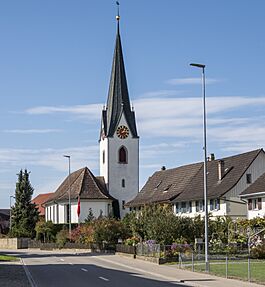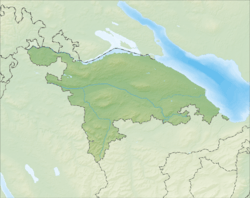Birwinken facts for kids
Quick facts for kids
Birwinken
|
||
|---|---|---|
 |
||
|
||
| Country | Switzerland | |
| Canton | Thurgau | |
| District | Weinfelden | |
| Area | ||
| • Total | 12.29 km2 (4.75 sq mi) | |
| Elevation | 550 m (1,800 ft) | |
| Population
(Dec 2020 )
|
||
| • Total | 1,330 | |
| • Density | 108.2/km2 (280.3/sq mi) | |
| Postal code |
8585
|
|
| Localities | Klarsreuti, Andwil, Mattwil, Happerswil-Buch, Birwinken | |
| Surrounded by | Berg, Bürglen, Erlen, Langrickenbach, Lengwil, Sulgen | |
Birwinken is a small town, also called a municipality, located in the Weinfelden district of the canton of Thurgau in Switzerland. It's a peaceful place with a rich history and beautiful natural surroundings.
Contents
History of Birwinken
Birwinken was first mentioned a very long time ago, possibly in the year 822! Back then, it might have been called Wirinchova. Later, in 1275, it was known as Birbichon.
In the 1300s, Birwinken was part of a larger territory called a Herrschaft, which was like a lord's land. This particular Herrschaft was named Spiegelberg. Because Birwinken was a bit far from the main part of Spiegelberg, it was sold to different owners over time. Finally, in 1640, the city of Zurich bought it.
The village's local court, which handled smaller legal matters, became connected to the town of Weinfelden in 1649. This connection lasted until 1798. For a short time, between 1803 and 1816, Birwinken was even a district capital, meaning it was an important center for the area.
The church in Birwinken is very old, mentioned as early as the 1100s. Around 1400, the church and its parish (the area it served) were looked after by monks from a monastery in Constance. This continued until 1529, when the Protestant Reformation happened. This was a big change in how people practiced Christianity. After that, the church became a Reformed parish, which included the nearby village of Andwil. Later, in 1578, it became a "filial church" of Langrickenbach, meaning it was a smaller church connected to a larger one. Catholics in the village started belonging to the parish of Berg after 1869.
In the 1800s, people in Birwinken started raising animals in addition to their traditional farming and fruit growing. In 1878, some factories opened, making textiles like woven cloth and embroidered items. These factories provided many jobs. However, as the textile industry changed in the 1900s, and because Birwinken was a bit isolated, many people moved away. This is why Birwinken hasn't developed much industry and has mostly remained a farming village. In 1990, a large part of the population (63%) still worked in agriculture.
Geography of Birwinken
Birwinken covers an area of about 12.35 square kilometers (about 4.77 square miles). A big part of this land, about 76%, is used for farming. Forests cover about 16.3% of the area. The rest of the land, about 6.9%, is used for buildings and roads. A small amount, 0.4%, is rivers or lakes.
Most of the built-up area is for industrial buildings, while houses and transportation areas make up smaller parts. Parks and sports fields are also part of the settled area. In the forested areas, most of the land is heavily wooded, and some parts have orchards or small groups of trees. For agricultural land, most is used for growing crops, and some is for orchards or vineyards. All the water in Birwinken comes from flowing rivers or streams.
The municipality is located in the Weinfelden district. It sits on the southern side of the Bodenseerücken mountains, which are hills near Lake Constance. Birwinken is about 2 kilometers (1.2 miles) east of Berg. The municipality includes several villages: Birwinken itself, Andwil, Happerswil-Buch, Klarsreuti, and Mattwil.
People of Birwinken (Demographics)
Birwinken has a population of about 1,265 people (as of December 2007). In 2008, about 7.3% of the people living here were from other countries. Over ten years (1997-2007), the population grew by about 8.1%. Most people in Birwinken (96.9% in 2000) speak German. The next most common languages are Albanian and Italian.
In 2008, there were slightly more men (51%) than women (49%) living in Birwinken. Most of the population were Swiss citizens.
The age groups in Birwinken (as of 2009) show that about 12.4% of the population are children aged 0-9, and 15.4% are teenagers aged 10-19. Adults aged 20-59 make up a large part of the population, and about 19.3% are seniors aged 60 and older.
In 2000, there were 433 households in Birwinken, with about 2.7 people living in each home on average. Most of the buildings were single-family homes.
The historical population of Birwinken has changed over time:
| year | population |
|---|---|
| 1850 | 1,333 |
| 1888 | 1,604 |
| 1900 | 1,407 |
| 1941 | 1,202 |
| 1950 | 1,261 |
| 1990 | 1,213 |
| 2000 | 1,216 |
Economy in Birwinken
In 2007, the unemployment rate in Birwinken was very low, at 0.93%. This means most people who wanted to work had jobs.
The economy of Birwinken is divided into three main parts:
- Primary sector: This includes jobs related to nature, like farming and forestry. In 2005, 171 people worked in this sector, with 56 businesses.
- Secondary sector: This involves making things, like in factories or construction. 53 people worked in this sector, with 15 businesses.
- Tertiary sector: This is about services, like shops, schools, or healthcare. 97 people worked in this sector, with 32 businesses.
In 2000, many people who lived in Birwinken (about 49.8%) traveled outside the municipality for work. However, 69 people also came into Birwinken for their jobs. Most people (52%) used a private car to get to work, while a smaller number (4.4%) used public transportation.
Religion in Birwinken
According to the 2000 census, about 20.2% of the people in Birwinken were Roman Catholic. A larger group, about 57.1%, belonged to the Swiss Reformed Church, which is a Protestant church. Some people belonged to other Christian churches (about 6.99%), and a small number (about 1.56%) were Islamic. About 8.63% of the population did not belong to any church or had no specific religion.
Education in Birwinken
Switzerland is known for its good education system. In Birwinken, about 74.5% of adults (aged 25 to 64) have completed higher education, either at a university or a specialized college.
Birwinken is part of the Berg-Birwinken school district, which includes both primary and secondary schools. In the 2008/2009 school year, there were 471 students in total.
- Kindergarten: There were 102 children in kindergarten. Most of them were girls (53.9%), and a small number (10.8%) were not Swiss citizens.
- Primary School: This level usually starts around age 5-6 and lasts for 6 years. There were 160 children in the lower primary level and 152 in the upper primary level.
- Secondary School: This level usually starts around age 12 and lasts for 3 years. Students are grouped based on their academic performance. There were 102 teenagers in the advanced school and 57 in the standard school.
See also
 In Spanish: Birwinken para niños
In Spanish: Birwinken para niños




